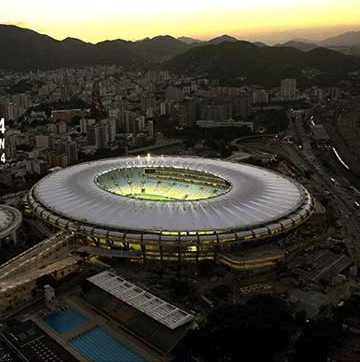
Brazil’s soccer and culture at Gables museum
This year, the World Cup is closer to Miami than it has ever been since the biggest international sports event visited the United States in 1994. It’s taking place in the soccer capital of the world and our South American neighbor, Brazil, a country whose presence is ubiquitous throughout South Florida. Although there was so much initial excitement about the Cup returning to its unofficial home – the national team has won more championships than any other, has never missed a Cup, and often includes numerous tops players on its roster – it has recently lost some of its luster. Social unrest and unhappiness with the massive amounts of money being spent on new stadiums, plus problems with completing those stadiums and the new infrastructure around them, have made more headlines than coverage of the Beautiful Game.
So intentional or not, the Coral Gables Museum’s exhibit, “12 Stadiums/12 Cities: Brazil 2014 World Soccer Destination,” is more appropriate and relevant than ever.
It explores the architecture of the new buildings, the cities that surround them, and the deep-seated urban soccer culture that is embedded in many of these metropolises.
All those topics are essential in understanding contemporary Brazil and its culture. When it was first awarded the Cup, the country was on a powerhouse economic roll, and the month-long event would be a showcase to let the globe know of its elite status. Visitors would see a country on the move and get a first-hand chance to revel in its famed music and artistic scenes, products of one of the most diverse countries in the world. Much of that culture has traditionally emerged out of the predominantly Afro-Brazilian slums or favelas of the major cities, along with its soccer players, all intricately tied together. And the top-notch architectural designs of the new structures across the country would reflect this multicultural, exciting new world of Brazil.
But as Brazil’s economy slumped, all the build-up got mucked up a bit, and the people of the favelas and elsewhere have started to get fed-up. The exhibit shows images of the great Brazilian cities shot by native artist photographers, architectural designs for the stadiums, videos of the cultural landscape, and interactive kiosks – all of which combines to tell a complex tale of a complicated contemporary nation.
Now, it’s only a few days left before we see what face Brazil will show, although it’s almost a given that its vaunted team will be ready for the scrutiny. You can start with the viewing in the plaza of the first match, Brazil v. Croatia, on June 12 at 4 p.m.
To augment the exhibit, a number of other events will be held, starting tonight with a samba band from 6-9 p.m.; on Sunday, author Roberto DaMatta talks about the essence of soccer; and Tuesday, professional player Joao Moraes will explain the game. Later in the summer there will presentations on the importance of soccer and music, and how to make a perfect Caipirinha.
“12 Stadiums/12 Cities: Brazil 2014 World Soccer Destination” runs through Sept. 14 at the Coral Gables Museum, 285 Aragon Ave., Coral Gables. For information on all the numerous events, go to coralgablesmuseum.org.
Recent Content
-
Artsarticle ·
-
Artsarticle ·
-
Artsarticle ·

